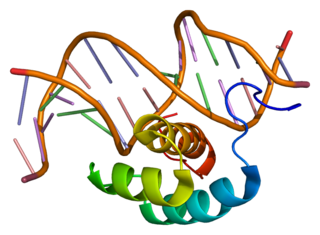Related Research Articles

The mir-10 microRNA precursor is a short non-coding RNA gene involved in gene regulation. It is part of an RNA gene family which contains mir-10, mir-51, mir-57, mir-99 and mir-100. mir-10, mir-99 and mir-100 have now been predicted or experimentally confirmed in a wide range of species. miR-51 and miR-57 have currently only been identified in the nematode Caenorhabditis elegans.

Homeobox protein CDX-2 is a protein that in humans is encoded by the CDX2 gene. The CDX-2 protein is a homeobox transcription factor expressed in the nuclei of intestinal epithelial cells, playing an essential role in the development and function of the digestive system. CDX2 is part of the ParaHox gene cluster, a group of three highly conserved developmental genes present in most vertebrate species. Together with CDX1 and CDX4, CDX2 is one of three caudal-related genes in the human genome.

Homeobox protein Hox-B6 is a protein that in humans is encoded by the HOXB6 gene.

Homeobox protein Hox-A5 is a protein that in humans is encoded by the HOXA5 gene.

Homeobox protein Hox-B5 is a protein that in humans is encoded by the HOXB5 gene.

Homeobox protein Hox-C8 is a protein that in humans is encoded by the HOXC8 gene.

Homeobox protein Hox-A7 is a protein that in humans is encoded by the HOXA7 gene.

Homeobox protein Hox-B2 is a protein that in humans is encoded by the HOXB2 gene.

Homeobox protein Hox-B9 is a protein that in humans is encoded by the HOXB9 gene.

Homeobox protein Hox-B3 is a protein that in humans is encoded by the HOXB3 gene.

Homeobox A4, also known as HOXA4, is a protein which in humans is encoded by the HOXA4 gene.

Homeobox protein Hox-A3 is a protein that in humans is encoded by the HOXA3 gene.

Homeobox protein CDX-1 is a protein in humans that is encoded by the CDX1 gene. CDX-1 is expressed in the developing endoderm and its expression persists in the intestine throughout adulthood. CDX-1 protein expression varies along the intestine, with high expression in intestinal crypts and diminishing expression along intestinal villi.

Homeobox protein Hox-A6 is a protein that in humans is encoded by the HOXA6 gene.
Homeotic genes are genes which regulate the development of anatomical structures in various organisms such as echinoderms, insects, mammals, and plants. Homeotic genes often encode transcription factor proteins, and these proteins affect development by regulating downstream gene networks involved in body patterning.

Homeobox protein Hox-A2 is a protein that in humans is encoded by the HOXA2 gene.
The Cdx gene family, also called caudal genes, are a group of genes found in many animal genomes. Cdx genes contain a homeobox DNA sequence and code for proteins that act as transcription factors. The gene after which the gene family is named is the caudal or cad gene of the fruitfly Drosophila melanogaster. The human genome has three Cdx genes, called CDX1, CDX2 and CDX4. The zebrafish has no cdx2 gene, but two copies of cdx1 and one copy of cdx4. The Cdx gene in the nematode Caenorhabditis elegans is called pal-1.

Hox genes play a massive role in some amphibians and reptiles in their ability to regenerate lost limbs, especially HoxA and HoxD genes.

Homeobox protein CDX-4 is a protein that in humans is encoded by the CDX4 gene. This gene is a member of the caudal-related homeobox transcription factor family that also includes CDX1 and CDX2.
Evx1 is a mammalian gene located downstream of the HoxA cluster, which encodes for a homeobox transcription factor. Evx1 is a homolog of even-skipped (eve), which is a pair-rule gene that regulates body segmentation in Drosophila. The expression of Evx1 is developmentally regulated, displaying a biphasic expression pattern with peak expression in the primitive streak during gastrulation and in interneurons during neural development. Evx1 has been shown to regulate anterior-posterior patterning during gastrulation by acting as a downstream effector of the Wnt and BMP signalling pathways. It is also a critical regulator of interneuron identity.
References
- ↑ Béland, M.; Pilon, N.; Houle, M.; et al. (2004). "Cdx1 Autoregulation is Governed by a Novel Cdx1-LEF1 Transcription Complex". Molecular and Cellular Biology. 24 (11): 5028–5038. doi:10.1128/MCB.24.11.5028-5038.2004. PMC 416402 . PMID 15143193.
- 1 2 Lengerke C, Daley GQ (2012). "Caudal genes in blood development and leukemia". Annals of the New York Academy of Sciences. 1266 (1): 47–54. Bibcode:2012NYASA1266...47L. doi:10.1111/j.1749-6632.2012.06625.x. PMC 3431192 . PMID 22901255.
- ↑ Mallo, G.V.; Rechreche, H.; Frigerio, J.M.; et al. (1997). "Molecular Cloning, Sequencing and Expression of the mRNA Encoding Human Cdx1 and Cdx2 Homeobox. Down-regulation of Cdx1 and Cdx2 mRNA Expression During Colorectal Carcinogenesis". International Journal of Cancer. 74 (1): 35–44. doi:10.1002/(sici)1097-0215(19970220)74:1<35::aid-ijc7>3.0.co;2-1. PMID 9036867. S2CID 46416077.
- ↑ Lohnes, David (2003). "The Cdx1 Homeodomain Protein: An Integrator of Posterior Signaling in the Mouse". BioEssays. 25 (10): 971–980. doi:10.1002/bies.10340. PMID 14505364.
- ↑ Beck, F.; Erler, T.; Russell, A.; et al. (1995). "Expression of Cdx-2 in the Mouse Embryo and Placenta: Possible Role in Patterning of the Extra-embryonic Membranes". Developmental Dynamics. 204 (3): 219–227. doi:10.1002/aja.1002040302. PMID 8573715. S2CID 19576530.